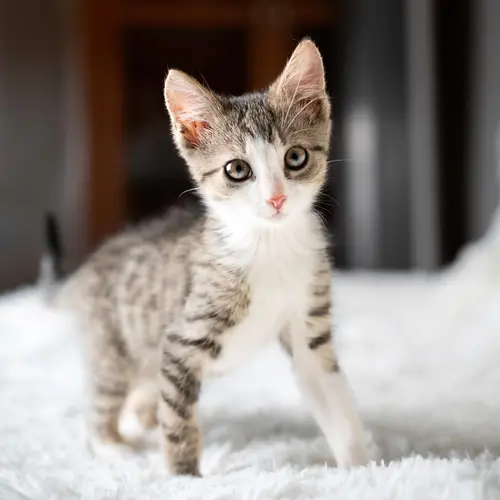Cats can groom themselves, so it may come as a surprise that brushing them is an important part of keeping them clean. Brushing your cat is one of the best ways to bond with them while keeping their coat and skin healthy.
Regularly brushing your cat helps to:
- Remove dirt and grease
- Remove dead hair and minimize shedding
- Stimulate blood circulation
- Remove dandruff and skin flakes
One or two brushings a week are all your cat needs. As your cat ages, brushing sessions will be more and more useful as they become less flexible and less able to groom on their own.
Healthy Coat and Skin
The first step to brushing your cat is to check over your cat’s coat. Healthy coats have a natural springiness and some gloss. Any bald spots, unusual bumps, patches of dead hair, or signs of ticks or fleas are cause for concern.
Both long- and short-haired cats benefit from grooming. However, each coat style needs different brushes and brushing techniques to produce the best results.
Brushing Short-Haired Cats
For a short-haired cat, all you need is a flea comb and a rubber or bristle brush. Rubber brushes work best for removing dead hair, while bristle brushes are excellent for removing dirt and debris.
First, run the flea comb through your cat’s fur to check for any potentially unwanted guests. If you spot signs of fleas or ticks, then you should do a more thorough combing to remove as many pests as possible and then speak with your pet’s vet about flea treatment.
With your rubber or bristle brush, start at your cat’s head and then work the brush toward their tail. Always brush in the direction their coat grows; otherwise, your cat may feel uncomfortable. Make sure to brush everywhere, including their chest, belly, and neck.
Brushing Long-Haired Cats
Long-haired cats are a little bit more of a commitment when it comes to grooming. That’s because they shed year-round. To minimize the amount of cat hair that escapes onto your clothes and to prevent your pet’s fur from matting, you should brush your long-haired cat several times a week.
You brush your kitty the same way as you would a short-haired cat. Bristle brushes and long-toothed combs work better than rubber brushes, however.
Start brushing your cat’s legs first, and then slowly work your way higher. Always brush in the direction the hair grows, but work on smaller sections to avoid tugging your cat’s fur or making snarls worse.
If you notice mats in your cat’s fur, sometimes you can gently tease them out with a comb. However, if the mats are extensive or severe, you may need to cut them out. Be careful not to cut your cat’s skin. You can also visit a professional groomer to remove the mats for you.
Body Checks
Grooming gives you a chance to check your cat for injuries or unexpected bumps. Run your hands along your pet’s abdomen to feel for bumps and wounds. Any black speckles or blood should be investigated further to see whether your kitty has gotten hurt or picked up parasites.
During grooming, you can also check your cat’s ears for dirt or wax buildup. Peek under their tail to see if they need feces cleaned out of their fur. If you spot any tan, rice-sized objects around your cat’s anus, you should bring them to the vet. This is a sign of tapeworms. Your cat will need treatment.
Skin Problems
Many cats, especially ones allowed outside, develop skin conditions not related to parasites. If you notice any of these symptoms, take your cat to the vet to get checked out:
- Increased shedding or bald patches
- Constant scratching
- Excessive licking and grooming of the fur
- Biting at the skin and fur
- Swelling or warm spots under the skin
Hairballs
Cats develop hairballs when they ingest too much dead hair when grooming themselves. You’ll know your cat has one when they start coughing them up onto the floor.
Regularly brushing your cat helps minimize hairballs. However, if your cat seems to have them often despite routine brushing, talk to your veterinarian.
Nervous Grooming
All cats spend part of each day grooming themselves. However, some cats can “over groom,” obsessively licking themselves. This is called nervous grooming.
Cats can give themselves sores and bald spots through nervous grooming. It can be a sign of an allergy, stress, or parasites that are making your cat uncomfortable. Schedule an appointment with your vet.
Diet
Just as with people, your cat’s diet has a big effect on their health. If your cat has coat or skin problems, they may be linked to a food allergy or a poor diet.
Talk with your vet about the right food for your cat’s age and weight, and consider limiting treats. The right food can help your cat recover from most fur or skin conditions quickly.

